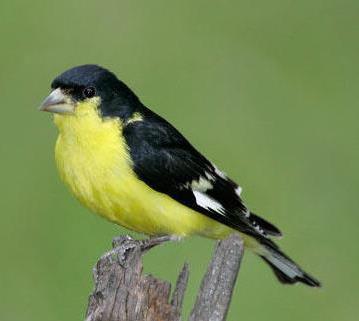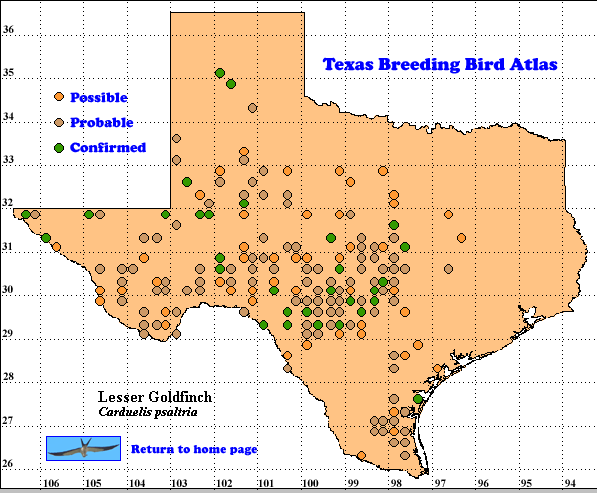The Lesser Goldfinch, also known in Texas as the Black-backed or Arkansas Goldfinch, is a small, social, seed-eating songbird. Adult males in breeding plumage are glossy black above, and bright yellow below, with white patches in the wings. Another color morph occurs from western New Mexico to the west coast of the United States. These birds have dull greenish backs and duller yellow underparts. In winter plumage males of both races are duller. Females of both morphs look similar and are duller than males. Much more knowledge is needed about the life history and taxonomy of Lesser Goldfinch. See Pyle (1997) and Watt and Willoughby (1999) for plumage details.
DISTRIBUTION. During the 1987-1992 TBBA field work volunteers found breeding pairs in many parts of the state, ranging from El Paso in the west to the southern Gulf Coast in the east, and well north into the Panhandle. Records are lacking from northeast Texas and the Red River valley. Oberholser (1974) reports an elevation range of 30 m (100 ft) to 2100 m (7000 ft).
In North America Lesser Goldfinch breeds from Washington, Oregon, California, Nevada, Utah, Colorado, Oklahoma and Texas south to the Isthmus of Tehuantepec in Mexico. Other populations are found at the north end of Mexico’s Yucatan Peninsula, in the Central American cordilleras, and in the Andes of northern South America (Watt and Willoughby 1999).
SEASONAL OCCURRENCE. Lesser Goldfinch is considered a permanent resident in much of its range in the United States, apparently withdrawing in winter from the colder parts of its range such as the Texas Panhandle. Its behavior within its range is not well understood. The presence or absence in a particular area may be influenced by available food. Lesser Goldfinches are known to form feeding flocks in winter. Egg dates for Texas range from March 18 to June 20, indicating a breeding period from early March to late July.
BREEDING HABITAT. In Texas, Lesser Goldfinches breed in lightly wooded areas with normal rainfall less than 90 cm (35 in) annually. In the Guadalupe Valley of the Edwards Plateau, the species is common in bald cypress and American sycamores near streams. The presence of wild sunflowers, giant ragweed (or other composites) and bird feeders may attract Lesser Goldfinches to urban areas. On hillsides they may be found in jumpers, oaks, and elms, usually near water. These birds often nest semi-colonially with each pair defending only the area near the nest (Oberholser 1974, Watt and Willoughby 1999).
The small, compact, deep cup is placed in a fork of a tree or bush. The female lays 3-6 (usually 4 or 5) eggs. During incubation the male often feeds her on the nest. The semi-colonial nesting habits of Lesser Goldfinches, the lack of territorial singing and other aspects of their behavior make nests difficult to find for atlasers.
Incubation takes about 12 days. Hand-raised birds flew from a nest at 14 days after hatching, probably similar to the nestling period in wild birds. No known instances of second successful nests have been reported in this species (Oberholser 1974, Watt and Willoughby 1999).
STATUS. Lesser Goldfinch is the only goldfinch breeding commonly in any part of Texas. The American (Carduelis tristis) winters throughout the state and is a very rare and local breeder in the northeast Panhandle and the northeast corner of the state. Lawrence’s Goldfinch (C. lawrencei) is accidental in Texas. Lockwood and Freeman (2004) list Lesser Goldfinch in summer as uncommon to locally abundant in the western half of Texas, south to the lower Rio Grande valley.
The species is generally rare and very local on the High Plains. Relative abundances derived from Breeding Bird Survey (BBS) data reach a maximum of 4-10 birds per 40 km (25 mi) route on the Edwards Plateau, falling to 2-3 birds per route in the southern Trans-Pecos region, and 1 and below in the rest of the Trans-Pecos, south Texas, the southern Panhandle and the Rolling Plains.
Disturbingly BBS data show a trend of -4.14 % population change per year for the period 1966-2003 from the 55 BBS routes in Texas which consistently detected this species (Sauer et al. 2004). Continued decreases of this magnitude will make Lesser Goldfinch more difficult to find outside its areas of highest abundance. Text by Robert C. Tweit (2004)
Literature cited:
Lockwood, M. W. and B. Freeman. 2004. The TOS Handbook of Texas Birds. Texas A&M University Press, College Station.
Oberholser, H. C. 1974. The bird life of Texas, Vol. 2. Univ. of Texas Press, Austin.
Pyle, P. 1997. Identification guide to North American birds, part 1. Slate Creek Press, Bolinas, CA.
Sauer, J. R., J. E. Hines, and J. Fallon. 2004. The North American Breeding Bird Survey, results and analysis 1966-2003. Version 2004.1. USGS Patuxent Wildlife Research Center, Laurel MD (Web site, http://www.mbr-pwrc.usgs.gov/bbs).
Watt, D. J., and F. J. Willoughby. 1999. Lesser Goldfinch (Carduelis psaltria). In The birds of North America, No. 392 (A. Poole and F. Gill, eds.). The Birds of North America, Inc., Philadelphia, PA.

